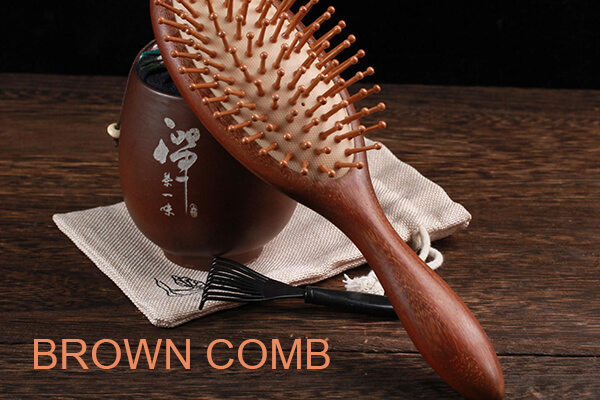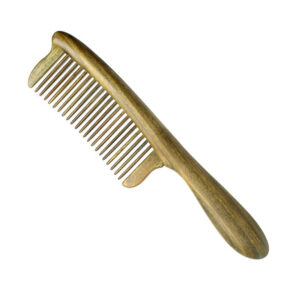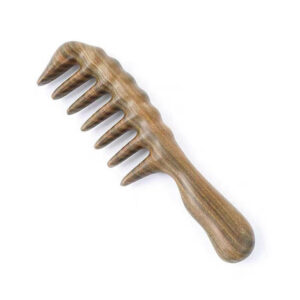
There is a cognitive misunderstanding: sandalwood only exists in the deep purple, black, or dark red system, and the brown color must be the result of artificial dyeing. There are a few kinds of precious sandalwood in nature that are born with a brown color, commonly known as brown sandalwood comb.
Sandalwood chromatography
Which species are naturally brown? The color of sandalwood is not determined by a single chemical pigment but by a symphony of flavonoids, oils, and oxidation in the wood cells.
1. East African black sandalwood (Dalbergia melanoxylon)
This hardwood, which grows in the arid zones of East Africa, has a distinctive golden-brown color when the heartwood is first cut, like melted toffee. As it oxidizes, the color deepens over the years to a deep chocolate brown with fine black streaks. Under ultraviolet light, its surface will glow with a purplish-bronze metallic luster, which is due to the iron content of its wood up to 0.12% (ordinary sandalwood is only 0.03%).
2. Central American sandalwood
Newly cut, this wood has a vibrant orange-brown color, as if the sun had set on the wood. After 3 years of exposure to air, oxidation transforms it into a rich burgundy brown with an ΔE value of 9.2 (a noticeable change to the naked eye). Its conduit lines show a unique “wavy” arrangement under the microscope, which is a key feature that distinguishes it from dyed imitations.
3. Burmese boxwood (commonly known as “Burmese rosewood”)
The light honey brown color has an irregular black ribbed texture, just like a splash of ink landscape painting. The brown color comes from a high concentration of rosewood astragal (a natural antioxidant), which in temperature-controlled experiments at 60 degrees Celsius will cause the wood color to fade from light brown to caramel, while stained wood will show mottled fading.
False brown wood species
The visual effect of using cheap wood dipped in a potion or high-pressure dyed to mimic natural brown sandalwood.
1. Stained purple core wood
Traders soak yellowish-purple core wood (Peltogyne) in a mixture of caramel coloring and ferrous sulfate to fake a brownish-black color similar to East African black sandalwood. However, when a cotton swab dipped in medical alcohol is rubbed vigorously, the dye comes off and reveals the grayish-white base of the original wood.
2. Medicine-soaked alder
Alder (Alnus) is bleached with hydrogen peroxide and then dyed brownish-red with nitroaniline dye. These imitations emit a strange green fluorescence under a 365nm UV lamp, whereas natural sandalwood only shows a faint blue-white light.
3. Resin synthesis “technology sandalwood”
Wood flour mixed with epoxy resin pressed imitation sandalwood, often titled “old mountain brown sandalwood” and other fictitious names. Its brown color is as uniform as plastic, and the density of only 0.8g/cm³ (real sandalwood > 1.1g/cm³), with a fingernail across the surface, will leave white scratches.
The scientific cause of the natural brown color
The brown color of sandalwood is not the result of the accumulation of a single pigment, but rather a complex symphony of biochemical and physical interactions. The mechanism for generating this color can be broken down into three core dimensions.
1. The chromogenic code of wood inclusions
Sandalwood cells in the flavonoids (such as sandalwood astragali, and sandalwood) are a natural “colorist”. These molecules contain a conjugated double-bond structure that absorbs specific wavelengths of visible light (450-500nm blue-violet light) and reflects a brownish-yellow spectrum. When astragalus combines with the phenolic hydroxyl groups in lignin, it forms stable quinone compounds that gradually oxidize the color from the initial light yellow to dark brown.
- Newly felled wood stage (0-1 year): The wood contains >30% moisture, and rosewood astragal exists in a free state, showing a bright honey-yellow color (L*a*b* color values: 70, 15, 35).
- Intermediate oxidation (1-3 years): Moisture drops to 15%-20%, Rosewood Astragali cross-links and polymerizes with lignin, color changes to amber-brown (color values: 55, 25, 40).
- Deep maturation (more than 5 years): Moisture stabilizes at 8%-10%, quinones form a three-dimensional network structure, and the final color is espresso brown (color values: 35, 30, 15).
2. Geographical imprint
- Arid regions (e.g. East Africa): High temperatures and little rain prompt sandalwood to secrete more oil (oil content > 23%), oil wrapped in flavonoid molecules to form a mirror reflection, resulting in a moist chocolate brown.
- Tropical rainforests (e.g. Southeast Asia): High humidity leads to the expansion of wood conduits, the formation of porous structure (porosity 12%-18%), and the light in the pore wall refracted many times to present a matte texture, brown tones gray.
- Mineral soil: Iron- and manganese-rich soil transports metal ions through the root system, which chelates with flavonoids to produce dark-colored complexes. For example, the iron content of East African black sandalwood reaches 0.12% (ordinary sandalwood is only 0.03%), which is the main reason for its black in brown.
3. Micro-revolution of photo-thermal catalysis
Ultraviolet light (UVB) and temperature in the color process play the role of “the gas pedal”.
- Ultraviolet light: 295nm wavelength UVB can cut the C-O bond of Rosewood Astragali, releasing reactive oxygen radicals, and prompting the reorganization of pigment molecules. Laboratory simulations show that 100 hours of continuous UV exposure is equivalent to 1 year of natural oxidation.
- Thermal catalysis: When the temperature > 40 ℃, the cellulose microfilaments of the lignocellular cell wall gap expand, accelerating the penetration of oxygen. For example, blowing the surface of sandalwood with a hair dryer at medium temperature (50℃) for 5 minutes increases its oxidation rate by 3 times.
5 tips to identify natural brown sandalwood comb
1. Texture perspective method
Natural sandalwood: longitudinal section visible continuous conduit lines, distribution of 8-12 per centimeter, a “zigzag” natural curvature (microscope magnification of 50 times). The black medullary line between the growth wheels in the cross-section, with a width of 0.1-0.3mm, is a biological mark that the dyeing process cannot reproduce.
Dyed imitations: The grain of the stained wood is blurred or shows the mechanical repetition of the printed grain. For example, imitation of East African black boxwood printing grain often appears parallel straight lines and the natural conduit of the interlocking mesh structure is very different.
2. Ultraviolet light method
Irradiate the surface of the comb with a 365nm UV lamp in a dark room and observe the fluorescence reaction.
Natural sandalwood: Emits weak blue-white fluorescence (due to the natural fluorescence of Rosewood Astragali), brightness ≤ 100 lumens.
Dyed imitations: No fluorescence or mottled green/purple patches (azo compounds in the dye react with UV light).
3. Odor analysis method
Rapidly rub the back of the comb with sandpaper for 10 seconds and smell the resulting odor.
Natural sandalwood: Emits warm sandalwood mixed with a milky odor (GC-MS detects the presence of α-sandalol and β-eucalyptol).
Dyed imitations: Release a pungent sour odor (formaldehyde) or burnt odor (high-temperature decomposition of resin glue).
4. Density verification method
Put the comb into saturated salt water (density 1.2g/cm³) and observe the sinking and floating.
Natural sandalwood: Sinking (East African black sandalwood density 1.3g/cm³, Central American micro-concave sandalwood 1.15g/cm³).
Dyed imitations: Floating or half-submerged (alder density 0.6g/cm³, poplar 0.45g/cm³).
5. Grease exudation method
Seal the comb in a transparent plastic bag and place it in a 40℃ environment for 24 hours.
Natural sandalwood: Amber-colored oil film appears on the inner wall of the bag (sandalwood oil oozing out), and the diameter of oil droplets 0.1-0.5mm.
Dyed imitation: No oil film or water vapor condensation appears (wood moisture content is too high).
Conclusion
Brown sandalwood comb, time-hardened natural aesthetics.
A true brown sandalwood comb is nature’s most exquisite living fossil. When an East African black sandalwood comb from the birth of honey brown, gradually oxidizes to a deep coffee color, each of its discolorations is a witness to the symbiosis of wood and mankind. Three years after the use of its surface, due to the human body oil infiltration emergence of the star-like golden silk, which is dyed imitations can never reach the traces of life.
When you hold a dyed comb, what you have is just an industrial replica on the assembly line; when choosing a natural brown sandalwood comb, you are participating in a natural creation across time and space. It will record your scalp temperature between morning and evening combing, and precipitating family memories in the cycle of years.
What are you waiting for?
Have a real sandalwood comb of your own!
Go!


